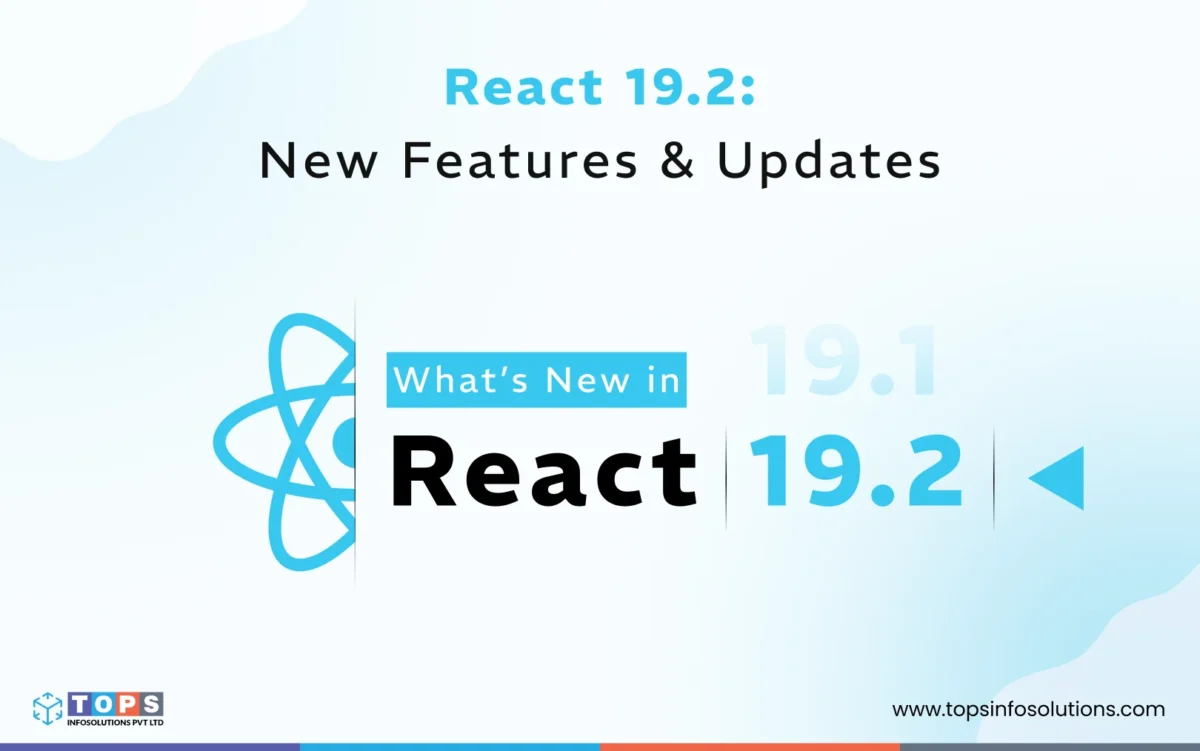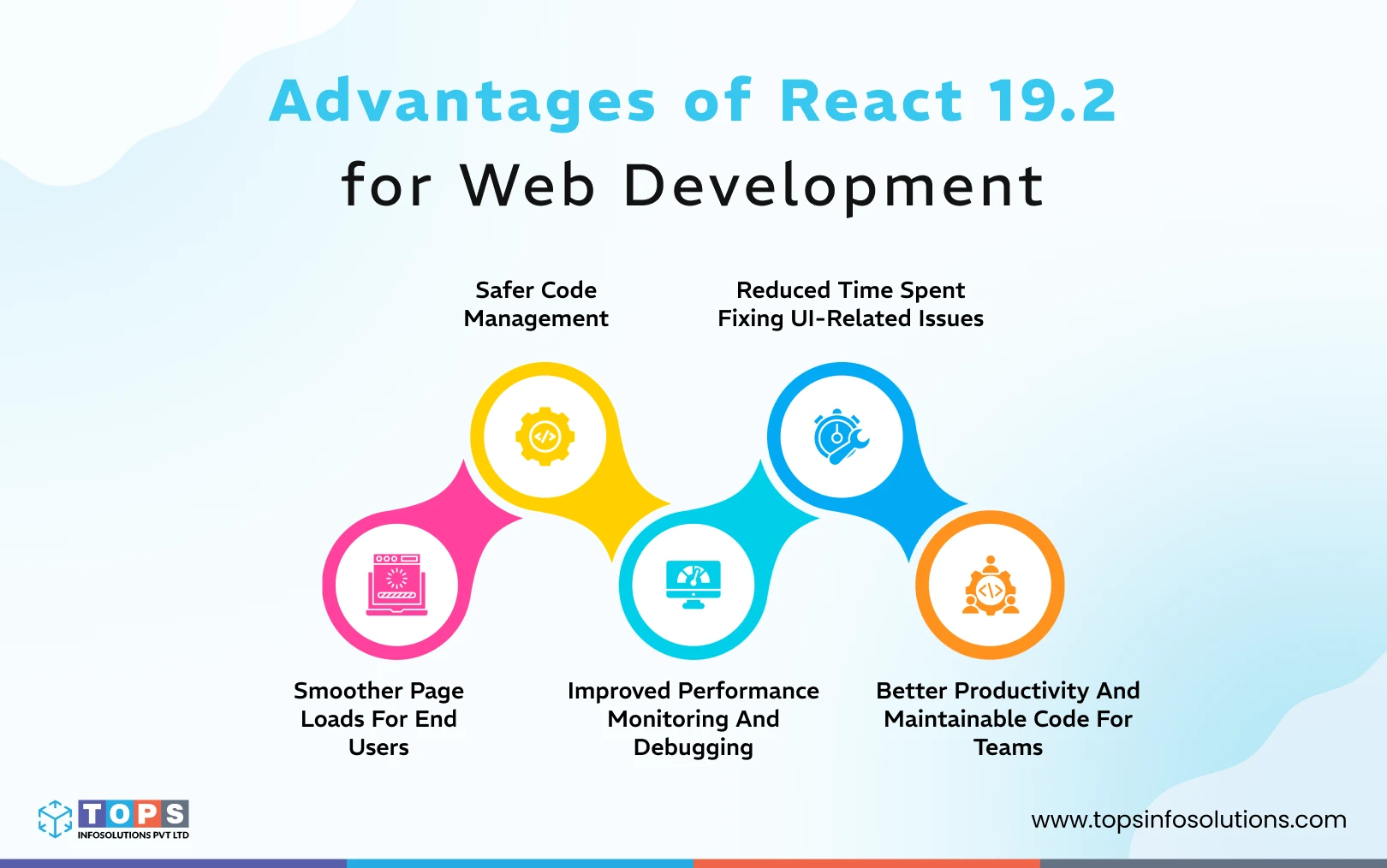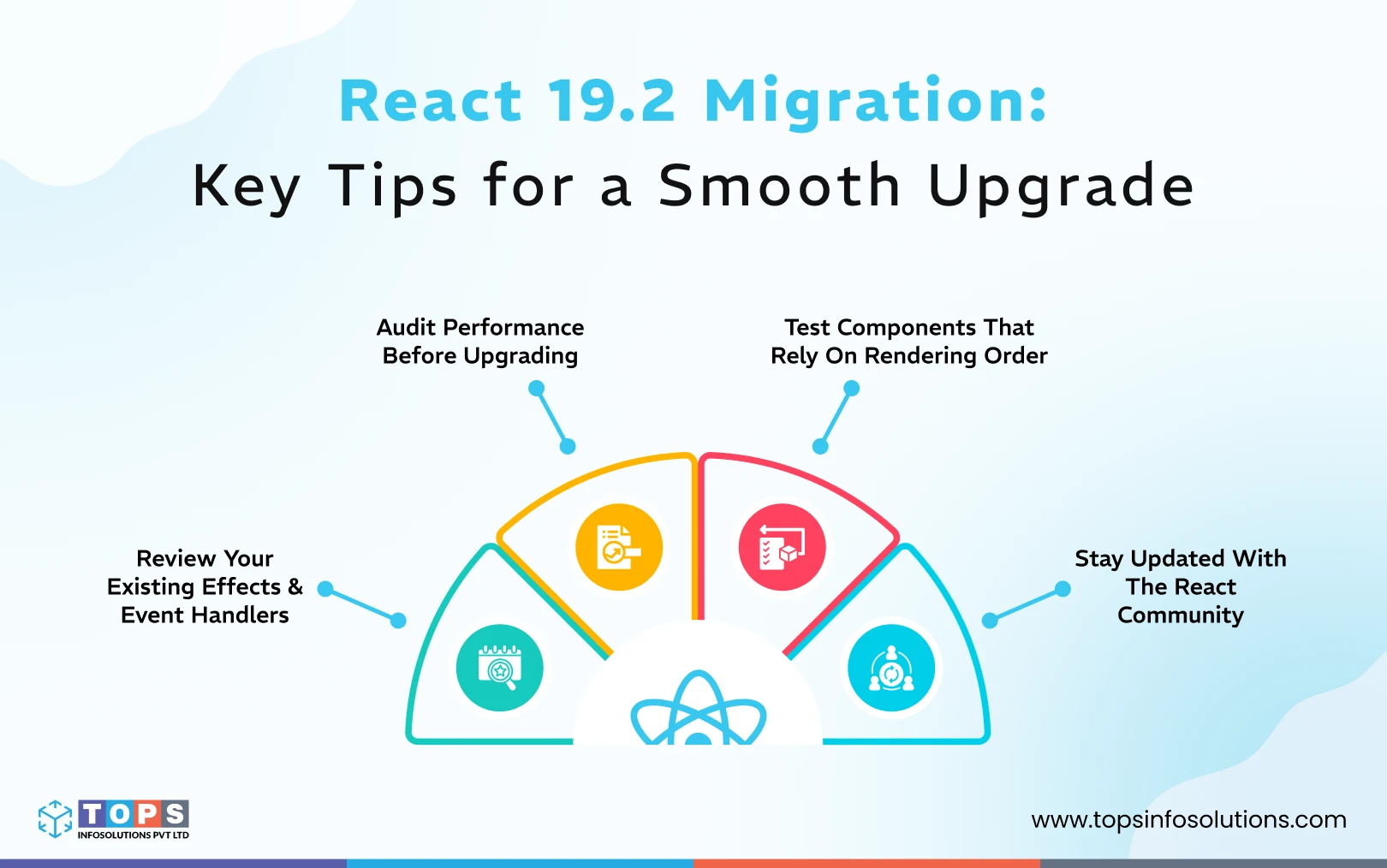Table of Contents
React 19.2: Key Features and How They Enhance Your Development Workflow

With its third update this year, React is driving meaningful improvements for user interfaces.
React 19.2 introduces highly anticipated features and delivers significant enhancements in rendering performance and server-side rendering capabilities.
Curious about what makes these updates so exciting? You’re in the right place.
In this blog, we break down the latest React 19.2 features, explore how it improves the overall React development workflows, and highlight what to consider if you plan to migrate.
What is React?
Let’s get a refresher as to what ReactJS is. It is a popular JavaScript library for building dynamic and interactive user interfaces that helps React developers break the interface into reusable components, rather than manually updating every element on a page. Each component describes what should appear, and React updates only the parts that change, making apps faster and more efficient.
At the core of React is the virtual DOM, which tracks changes in memory before updating the real page. This approach ensures smooth rendering, better performance, and easier maintenance.
Over time, React has evolved to meet the needs of modern web applications. It introduced React 19 in December 2024, which introduced improvements like server components and enhanced rendering capabilities. Since then, it has introduced two more updates: React 19.1 in June 2025 and React 19.2 in October 2025.
React 19.2 builds on the foundation of React with features that simplify development, improve performance, and give developers more control over how their apps behave.
What’s new in React 19.2?
Now that you have a clear background about React updates, let me break down the latest update in terms of its features.
1. <Activity>
<Activity> is the highlight of the latest update since it lets developers control which parts of the UI are ‘active’ at any given time. Developers often struggled to manage which parts of a complex UI should update, leading to sluggish interfaces. <Activity> lets you prioritize important elements while temporarily pausing less critical ones. For example, on a dashboard, charts can remain active while background notifications are paused, giving users a smoother experience.
The component allows you to define modes for different UI elements:
- visible – The component is fully active and rendered immediately.
- hidden – The component exists but doesn’t update until it becomes active again.
- suspended – The component is temporarily paused, conserving resources, and resumes only when necessary.
2. useEffectEvent
Managing side effects like network requests or timers has always been one of the trickiest parts of building React apps. In earlier versions, these effects could behave unpredictably, especially in complex rendering scenarios. I’m sure you’ve often run into issues like stale data, duplicated requests, or unexpected behavior when components re-rendered. The useEffectEvent hook addresses these challenges by ensuring side effects are handled safely and consistently.
With useEffectEvent, you can
- Create a stable function reference that automatically integrates with React’s rendering cycle.
- Ensure side effects execute only when needed, eliminating duplication or conflicts caused by re-renders.
- Ensure the hook is fully compatible with React’s concurrent features, making it safer for modern applications.
3. cacheSignal
A common occurrence in previous versions was repeatedly calculating values in web applications that don’t change often. It slows down rendering in data-heavy apps. New features in React 19.2 introduce cacheSignal, which solves this problem by efficiently storing and reusing values, improving both performance and developer experience. Let’s take a look at how:
- cacheSignal creates a cached reactive value that persists across renders
- When the value is requested again, React retrieves it from the cache instead of recalculating it.
- This approach reduces unnecessary computations and keeps your app running smoothly, even with complex logic.
4. Performance tracking
As applications grow, there is a pressing need to identify performance bottlenecks. You often struggle to pinpoint which components or hooks were slowing down the app, leading to wasted time and poor user experiences.
React 19.2 introduces enhanced performance tracking tools to make this process easier and more precise:
- React now visualizes its internal workload prioritization, distinguishing between high-priority user interactions (like clicks or typing) and lower-priority updates (like background transitions).
- Developers can see when updates are paused or resumed, helping them understand how React balances tasks efficiently.
- The new Components view displays the hierarchical flow of component processing, showing which ones are rendering, re-rendering, or executing effects, and how much time each consumes.
5. Partial pre-rendering and server improvements
In earlier React versions, server-side rendering (SSR) generated entire pages before sending them to the browser. While this is effective, let’s just agree that Partial Pre-rendering (PPR) is a smarter approach that blends statics and dynamic rendering to deliver faster, more efficient pages. These latest features in React 19.2 perform the following functions:
- PPR lets React render only essential parts of a page first, like navigation bars or hero sections, while deferring dynamic parts until needed.
- Users can see and interact with content almost instantly, while the rest of the page loads in the background.
- It improves server optimizations, reducing the overhead involved in streaming content from the server to the browser.
Benefits of React 19.2 for Web Development
Now that you know what the React 19.2 update is about, we can understand what this means for web development in the broader sense. Each improvement in this release translates into tangible benefits for both developers and end users:

1. Smoother page loads for end users
With partial pre-rendering and smarter rendering priorities, React 19.2 ensures that the most important content appears instantly while the rest loads seamlessly in the background. This leads to shorter waiting times, which is a crucial factor in keeping users engaged.
2. Safer code management
Latest React 19.2 features like the useEffectEvent hook simplify side-effect handling, reducing common bugs and data mismatches. You can now write cleaner, more predictable code that behaves consistently across different rendering cycles.
3. Improved performance monitoring and debugging
With improved performance tracking, you get clear visibility into React’s internal processes. You get greater control over the performance since you can see which components slow things down, how tasks are prioritized, and where to optimize. Debugging becomes more data-driven rather than guesswork.
4. Reduced time spent fixing UI-related issues
With features like <Activity> and smarter effect handling, developers spend less time troubleshooting UI flickers or state inconsistencies. The framework now manages much of this complexity behind the scenes.
5. Better productivity and maintainable code for teams
React 19.2 promotes cleaner patterns and better control, making collaboration easier. Teams can focus on building new features rather than constantly patching or refactoring old ones.
Read More: Key Reasons to Use ReactJS for Modern Web Applications
Tips to consider before migrating to React 19.2
If you’re working with React 18 or 19, migrating to React 19.2 isn’t too much of a hassle. However, to make the best of the update, it’s worth planning your transition carefully to ensure nothing breaks in production and you’re in align with the React app development best practices.

1. Review your existing effects and event handlers
If your app relies heavily on useEffect, review how side effects are structured. The new useEffectEvent hook helps simplify complex event-driven logic and prevents stale references. But just make sure to refactor gradually rather than replacing everything at once.
2. Audit performance before upgrading
Run a quick performance audit on your current app so that you have a baseline to compare improvements after switching to the latest version. You’ll be able to see tangible gains from features like partial pre-rendering and caching.
3. Test components that rely on rendering order
Since React 19.2 introduces smarter workload prioritization, test components that depend on specific render timing. Use the new performance visualization tools to confirm that updates occur as expected.
4. Stay updated with the React community
React’s official documentation and GitHub discussions often highlight early insights and migration tips from developers. Keeping an eye on these channels ensures you’re aligned with best practices.
Bring the Power of React 19.2 to Your Next Project with TOPS
The new features in React 19.2 aim to make web applications faster, smarter, and easier to maintain. With its new tools for performance, rendering, and stability, developers can create seamless experiences.
At TOPS, we stay ahead of every new React release to bring the best of modern development to our clients. As a React app development company, our team helps you integrate new features, optimize app performance, and build solutions that scale effortlessly.
